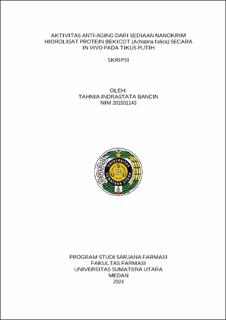| dc.description.abstract | Background: Prolonged exposure to UV rays can lead to the formation of free radicals that can accelerate the aging process of the skin. Abnormal levels of free radicals entering the skin can attack vulnerable compounds, such as lipids, proteins and have implications for the onset of various diseases. Proteins in snails (Achantina fulica) have a function to maintain body cells and can improve signs of aging on the skin such as dry, rough skin, wrinkles, changes in skin color, thinning of the epidermal layer, changes in collagen structure, and the onset of inflammation.
Purpose: To test the effectiveness of snail protein hydrolysate (A. fulica) in cream and nanocream preparation as anti-aging on white rat skin.
Method: This study used an experimental method with the independent variable used, namely variations in the concentration of snail protein hydrolysate (A. fulica) in cream and nanocream preparations by conducting preparation irritation tests and evaluating anti-aging activity macroscopically and microscopically on rat skin exposed to UVB light.
Results: The results showed that the snail protein hydrolysate nanocream preparation did not irritate the skin. The results of macroscopic and microscopic examinations in the negative rat group showed changes in skin color to be darker, rough, epidermis thinned, collagen structure changed, and there was a moderate degree of inflammation in the skin. In the group of rats given the nanocream preparation, there was no change in skin color, smooth, thickened epidermis, dense collagen structure, and there was no degree of inflammation. In the group of rats given the cream preparation there was also no change in skin color, had a thick epidermal layer, had a dense collagen structure, but there was a mild degree of inflammation. The results of statistical analysis showed that there were significant differences (p < 0.05) between snail protein hydrolysate nanocream preparations at various concentration variations, where the best anti-aging effect was found in 10% snail protein hydrolysate nanocream.
Conclusion: The 10% snail protein hydrolysate nanocream preparation had a better anti-aging effect than the other tested preparations. | en_US |


